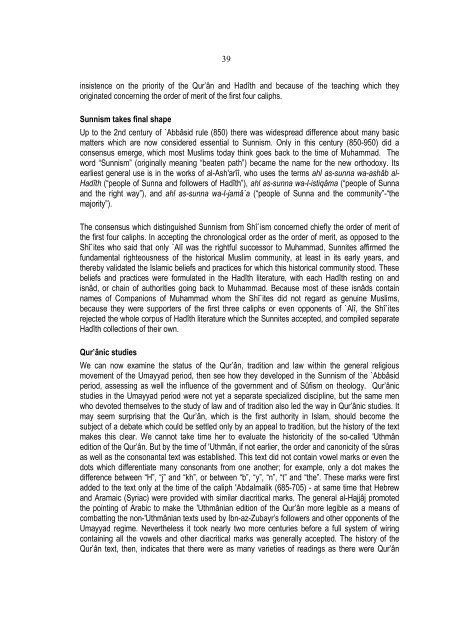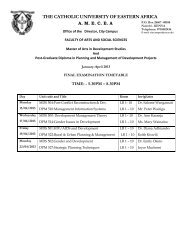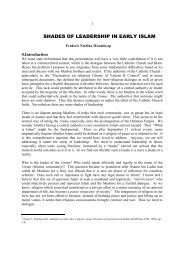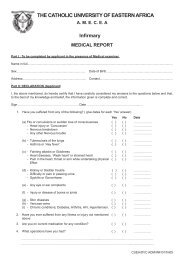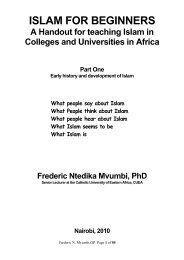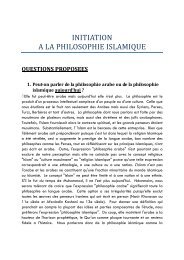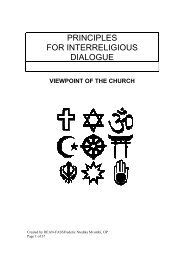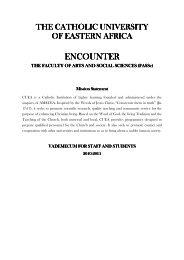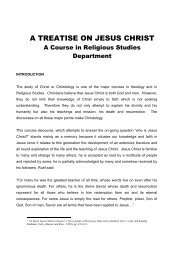INTRODUCTION TO ISLAMIC THEOLOGY.pdf - CUEA
INTRODUCTION TO ISLAMIC THEOLOGY.pdf - CUEA
INTRODUCTION TO ISLAMIC THEOLOGY.pdf - CUEA
Create successful ePaper yourself
Turn your PDF publications into a flip-book with our unique Google optimized e-Paper software.
39insistence on the priority of the Qur’ân and Hadîth and because of the teaching which theyoriginated concerning the order of merit of the first four caliphs.Sunnism takes final shapeUp to the 2nd century of `Abbâsid rule (850) there was widespread difference about many basicmatters which are now considered essential to Sunnism. Only in this century (850-950) did aconsensus emerge, which most Muslims today think goes back to the time of Muhammad. Theword “Sunnism” (originally meaning “beaten path”) became the name for the new orthodoxy. Itsearliest general use is in the works of al-Ash'arîî, who uses the terms ahl as-sunna wa-ashâb al-Hadîth (“people of Sunna and followers of Hadîth”), ahl as-sunna wa-l-istiqâma (“people of Sunnaand the right way”), and ahl as-sunna wa-l-jamâ`a (“people of Sunna and the community”-“themajority”).The consensus which distinguished Sunnism from Shî`ism concerned chiefly the order of merit ofthe first four caliphs. In accepting the chronological order as the order of merit, as opposed to theShî`ites who said that only `Alî was the rightful successor to Muhammad, Sunnites affirmed thefundamental righteousness of the historical Muslim community, at least in its early years, andthereby validated the Islamic beliefs and practices for which this historical community stood. Thesebeliefs and practices were formulated in the Hadîth literature, with each Hadîth resting on andisnâd, or chain of authorities going back to Muhammad. Because most of these isnâds containnames of Companions of Muhammad whom the Shî`ites did not regard as genuine Muslims,because they were supporters of the first three caliphs or even opponents of `Alî, the Shî`itesrejected the whole corpus of Hadîth literature which the Sunnites accepted, and compiled separateHadîth collections of their own.Qur’ânic studiesWe can now examine the status of the Qur’ân, tradition and law within the general religiousmovement of the Umayyad period, then see how they developed in the Sunnism of the `Abbâsidperiod, assessing as well the influence of the government and of Sûfism on theology. Qur’ânicstudies in the Umayyad period were not yet a separate specialized discipline, but the same menwho devoted themselves to the study of law and of tradition also led the way in Qur’ânic studies. Itmay seem surprising that the Qur’ân, which is the first authority in Islam, should become thesubject of a debate which could be settled only by an appeal to tradition, but the history of the textmakes this clear. We cannot take time her to evaluate the historicity of the so-called 'Uthmânedition of the Qur’ân. But by the time of 'Uthmân, if not earlier, the order and canonicity of the sûrasas well as the consonantal text was established. This text did not contain vowel marks or even thedots which differentiate many consonants from one another; for example, only a dot makes thedifference between “H”, “j” and “kh”, or between “b”, “y”, “n”, “t” and “the”. These marks were firstadded to the text only at the time of the caliph 'Abdalmalik (685-705) - at same time that Hebrewand Aramaic (Syriac) were provided with similar diacritical marks. The general al-Hajjâj promotedthe pointing of Arabic to make the 'Uthmânian edition of the Qur’ân more legible as a means ofcombatting the non-'Uthmânian texts used by Ibn-az-Zubayr’s followers and other opponents of theUmayyad regime. Nevertheless it took nearly two more centuries before a full system of wiringcontaining all the vowels and other diacritical marks was generally accepted. The history of theQur’ân text, then, indicates that there were as many varieties of readings as there were Qur’ân


